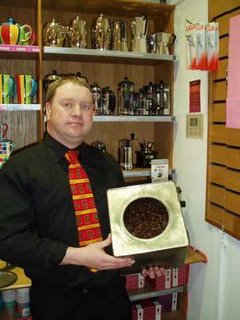Needs Must

The expression ‘Needs must when the devil rides’ came to mind when I was looking for an alternative to the espresso machine. To be honest, when I want to make coffee from a single estate, the best method I’ve found is the glass cafetiere. Alias the press pot, French Press (I like that one as it sounds more like a guillotine) or the glass plunger, some of my customers describe it by just moving their hand up and down as they say ‘I make it in one of those pushy downy things!’
When you use a cafetiere there are some things you need to do or you’ll just end up making a mess of your coffee. First make sure that the coffee is course ground and fresh. Remember to prime your glass with warm water before you put in the coffee grinds and don’t be lazy about reusing previously boiled water. You need to refill the kettle with fresh water as your coffee needs good oxygenated water. Fill the cafetiere with some warm tap water and then pour it out straight out. Otherwise the glass could crack when you pour in the hot water. This is a really useful tip as I currently do a roaring trade in replacement glasses for cafetieres on the high street.
When filling up your cafetiere with coffee there really is one simple rule to remember. When you drop the plunger in an empty cafetiere, you will notice a small gap left at the bottom. Never fill the cafetiere above that point – simple. The best way to work it out is to hold the cafetiere at a 45° angle and when the coffee about half way up the base, stop.
Now you are ready to add the hot water from your kettle. Remember to wait for the water to stop boiling before you pour it onto you coffee grinds. Water should only be between 80° C to 90°C when added to coffee. If the water is too hot then you’ll burn the coffee and it will taste bitter. Let the water and coffee to settle for about 4 minutes, do not stir the mix as the crust forming on the top will help to keep the water temperature stable. Before you place the plunger onto your cafetiere, you might want to just grab a spoon and gently break the crust by allowing the water to flow through to the top of the crust. This is great if, like me, you really want to smell your coffee at it freshest, otherwise just plunge away. Then sit back, relax and enjoy.



